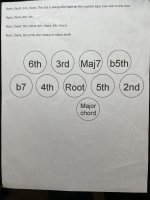Jaime_Dergut
Well-known member
Hello there,
I'm excited today because I came to a realization after playing one of my accordions in the streets.
When I was fooling around with the chords on the treble side, and suddenly I had the idea of alternating bass on C, cm, G and doing the same thing on the treble side.
I quickly realized that the fingering I used (1, 2, 3) and the position of G next to C on the bass side was pretty convenient to make an Om paa paa pattern in both sides.
The same logic applies to the rest of the buttons on the bass side. Next to each other is the respective chord that you will use on the treble side, for example:
B,bM, F#
To create a bm sound on the treble side, you have to press the chord of B, D and F#. By using 1,2 and 3, respectively, you can create an alternative bass technique on the treble side by hitting (note: number represents fingers starting with thumb at 1):
1 -> B
1,2,3 -> B,D,F#
3 -> F#
Now, on the bass side, B and F# are next to each, and so are the rest of the tunes according to its harmonic arrangement. Isn't this fascinating?
I finally understood the logic behind the arrangement of the stradella system layout, and it's brilliant! I'm marvelled by the ingenuity of this.
I'm glad I am able to share this with you all, even thought it may sound basic.
Thanks for your time and attention, and please, share your thoughts if there is something else you would like to say about harmony and the stradella system.
Regards,
Jaime
I'm excited today because I came to a realization after playing one of my accordions in the streets.
When I was fooling around with the chords on the treble side, and suddenly I had the idea of alternating bass on C, cm, G and doing the same thing on the treble side.
I quickly realized that the fingering I used (1, 2, 3) and the position of G next to C on the bass side was pretty convenient to make an Om paa paa pattern in both sides.
The same logic applies to the rest of the buttons on the bass side. Next to each other is the respective chord that you will use on the treble side, for example:
B,bM, F#
To create a bm sound on the treble side, you have to press the chord of B, D and F#. By using 1,2 and 3, respectively, you can create an alternative bass technique on the treble side by hitting (note: number represents fingers starting with thumb at 1):
1 -> B
1,2,3 -> B,D,F#
3 -> F#
Now, on the bass side, B and F# are next to each, and so are the rest of the tunes according to its harmonic arrangement. Isn't this fascinating?
I finally understood the logic behind the arrangement of the stradella system layout, and it's brilliant! I'm marvelled by the ingenuity of this.
I'm glad I am able to share this with you all, even thought it may sound basic.
Thanks for your time and attention, and please, share your thoughts if there is something else you would like to say about harmony and the stradella system.
Regards,
Jaime

